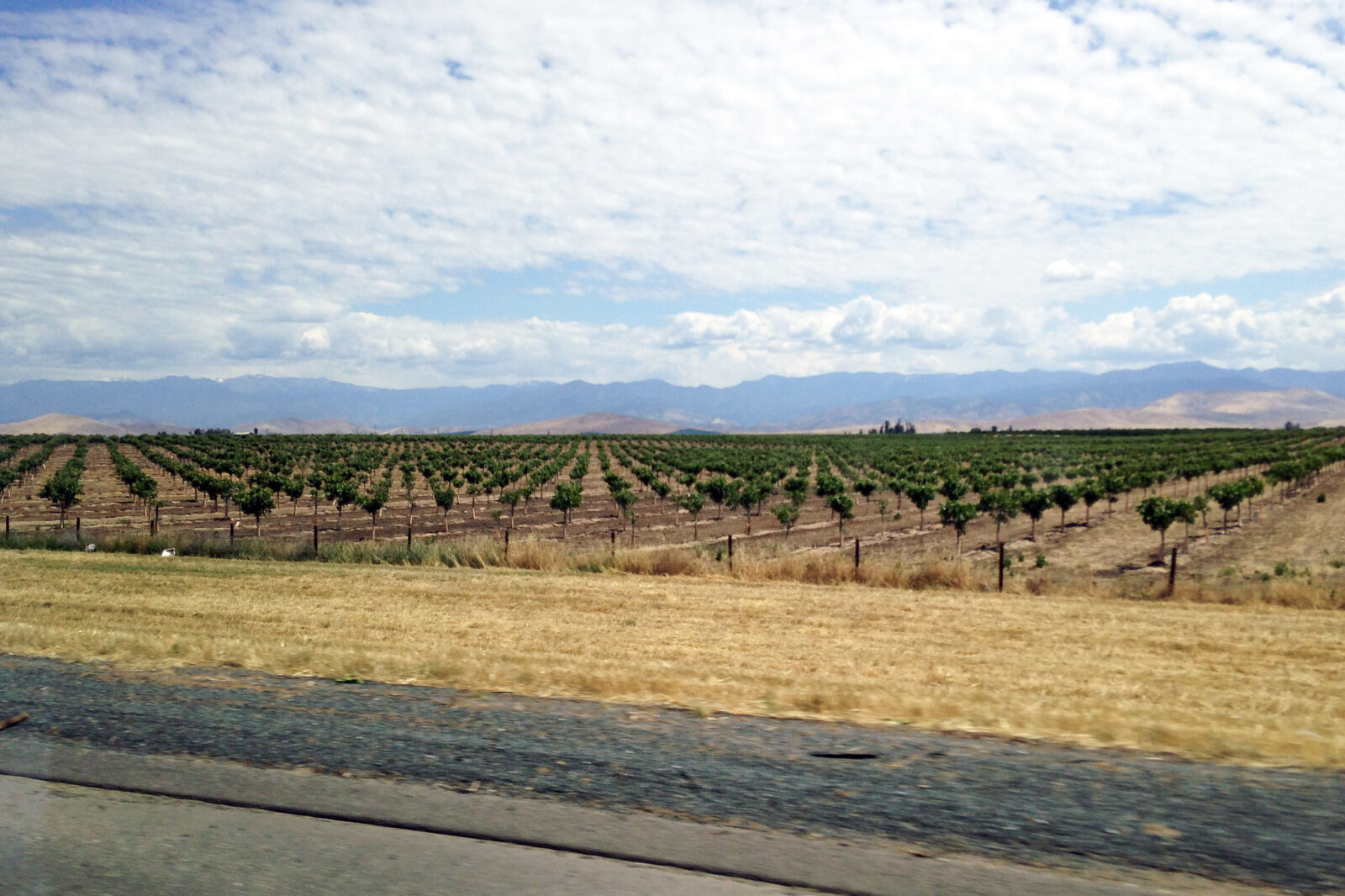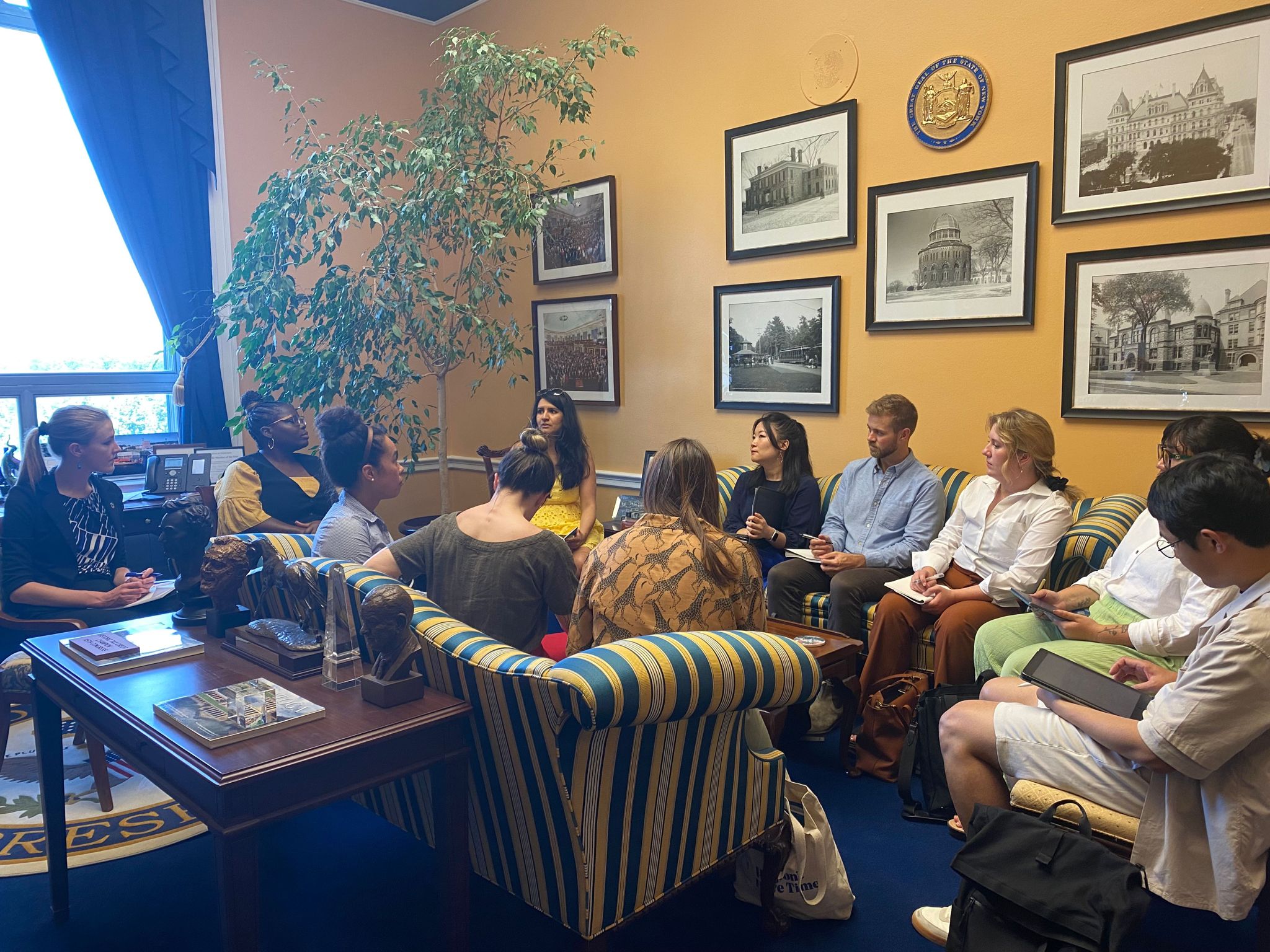Authored by Jake Ferrell, Carbon Justice Fellow at the National Wildlife Federation & Audrey Alonso, Digital Organizer at Our Climate

Orchard in California’s Central Valley. Credit: Ian Abbott/Flickr
Crops, cattle farms, and oil wells. Look out over the landscapes of Kern County, California, and you can find the physical infrastructure of various industries. The latest industry poised to shape Kern County landscapes is carbon dioxide removal.
California appears set to become a national leader in carbon dioxide removal (CDR)—a climate strategy that removes CO2 directly from the ambient air and sequesters it in a form where it is prevented from re-entering the atmosphere. CDR addresses the climate crisis by targeting excess atmospheric CO2, a result of societal industrialization, and can range from natural solutions like reforestation to more technological processes like direct air capture (DAC).
Carbon Removal Projects in California Receive Federal Support
When the Department of Energy (DOE) announced the first round of awardees for its $3.5 billion Direct Air Capture Hubs (DAC Hubs) program in August 2023, no fewer than four projects in California were selected, the most of any one state. The most advanced project, led by a subsidiary of fossil fuel company California Resources Corporation, will receive up to $11.8 million to conduct a Front End Engineering Design (FEED) study to explore the potential for a DAC hub in Kern County, California.
The other three—led by Aera Energy, Chevron, and the University of California—will receive up to $3 million each to explore the feasibility of their proposed projects. All projects are located in the southern part of California’s Central Valley, in and around Bakersfield and Kern County.
What Goes On in the Central Valley?
Oil and gas production in California. Credit: John Ciccarelli, BLM
The Central Valley is no stranger to economic sectors of national importance. According to the U.S. Geological Survey, the Central Valley is among the main agricultural regions in the U.S., producing a quarter of the nation’s food, including 40% of the fruits and nuts consumed. Alongside agriculture, fossil fuel extraction dominates the landscape.
In 2019, Kern County was the leading oil producing county in the state, and the seventh largest in the country. While these industries helped build a city like Bakersfield into what it is today, participants at a carbon removal workshop convened earlier this year in Bakersfield, were quick to point out the environmental degradation and human health consequences those same industries have brought with them.
Though these consequences impact nearly all residents of Bakersfield and the broader Central Valley, the burden falls especially on low-income communities and communities of color. Bakersfield, a city of over 400,000 people, is located 100 miles northeast of Los Angeles. Census data shows around half of the residents identify as Latinx, 7% Black, 7% Asian, and around 30% as white (these numbers may not be fully representative of the population, due to Kern’s large population of undocumented people). More than 16% of county residents live below the poverty line.
The CDR spotlight shines so brightly on the Central Valley because its landscape fits the criteria set forth by Congress guiding DOE’s selection process, including: access to geological storage reservoirs for CO2, ongoing economic reliance on the fossil fuel industry, proximity to low-carbon electricity sources, and location as an economic opportunity zone.
However, given the ongoing history of this region, the characteristics that make the Central Valley an attractive site for DAC in the federal government’s eyes are the same characteristics that may make communities in the area skeptical of DAC.
Indeed, “economic opportunity zones” refer to areas identified by the Internal Revenue Service (IRS) where developers are offered tax benefits to “spur economic growth and job creation in low-income communities” but the environmental degradation and public health consequences of the fossil industry’s boon in particular, are frequently centered by Kern residents, even if they also acknowledge the jobs that come with the industry’s presence.
Given DOE’s mandate to prioritize applications for these areas, and the mandate’s demographic overlap with vulnerable groups, it is likely that most or all of the DAC Hub locations will have large shares of BIPOC populations, along with those of low socioeconomic status. This is true of Kern County, where nearly 70% of residents are BIPOC and the average income is one third of the state’s average.
The long history of unjust infrastructure siting and legacies of environmental injustice in the United States may bolster and inform skepticism and resistance to further projects, particularly in the communities that have borne the brunt of hosting extractive industries.
Hope & Skepticism
So, how are different groups and actors in California approaching the prospect of a new carbon removal industry blossoming in the state? At the state level, California has positioned itself as a leader in developing CDR policy—it is the first US state to incorporate specific quantitative targets for CDR with its latest Scoping Plan for reaching carbon neutrality, and there have been a flurry of state bills recently passed supporting CDR.
Local government officials are leading calls to bring the burgeoning carbon management industry to the Central Valley with the announcement of a Carbon Management Business Park in Kern County. Lorelai Oviatt, the director of Kern County’s Planning and Natural Resources Department, has stated that the vision is to build a massive solar farm to power DAC plants, so as to replace the county’s declining agricultural revenues due to droughts continuing to plague the Southwest. For Kern alone “at the top end this could produce $68 million a year in county property tax revenue to the county, $25 million to surrounding cities, and 23,000 jobs,” Oviatt noted. “That is hope!”
But it is not so simple. Local residents have expressed opposition to carbon capture and storage (CCS) projects in the past. Part of that opposition is centered around the fact that captured CO2 would have been used to extract more oil in a process known as enhanced oil recovery (EOR).
Today, the California Resources Corporation FEED study has expressly stated that its DAC Hub would not utilize CO2 for EOR, however Chevron and Aera Energy have not yet made statements either way. Some participants in a Bakersfield community DAC workshop signaled that Chevron or Aera Energy involvement in a project would be a red line for them.
“Chevron and Aera Energy own this town,” stated one participant, and other participants agreed that they did not always trust local elected officials to support the needs of the community over industry. Workshop participants were frustrated that fenceline communities like theirs always seemed to be the first choice for new industrial projects, and voiced skepticism over whether DAC would be any different from past projects that did not pursue a caring relationship with the community.
Climate Change in the Central Valley
California’s Central Valley is experiencing extreme heat in the summer months. Credit: Flickr/Eric Sonstroem
Anyone who lives in or has experienced the summer months in the Central Valley likely knows firsthand the extreme heat faced by residents every year, and how it is only projected to get hotter. “By midcentury, the Central Valley is projected to experience average heat-health events that are two weeks longer” states a Summary of Projected Climate Change Impacts on California.
Experiencing 90° F October days is already a common event for those living in the Valley. Alongside extreme heat, there is also the aforementioned drought. Audrey Alonso, an NWF-American University Carbon Removal Justice Fellow was born and raised in the Central Valley, and personally remembers learning how to deal with drought as a kid and has maintained those water-conserving lessons to this day.
The Central Valley depends on a functioning irrigation system to maintain arable land, and droughts have put a massive strain on many households and farms in the area. The 2021 drought caused communities to incur $1.7 billion in costs, and led to the loss of over 14,000 jobs. These issues, exacerbated by climate change, are a growing problem that continue to affect the region’s agricultural production and the livelihoods that support it.
Climate change is bringing increasingly severe and frequent heat waves and droughts to Kern County; creating dusty conditions; exacerbating air quality issues, as the region consistently ranks as one of the worst in the U.S.; and threatening human health, especially that of vulnerable populations like the elderly and those who labor outside, including farmworkers.
It is important that any Kern County DAC projects acknowledge this context and refrain from becoming a burden to communities as well as limited resources they might share, like water. If they are able to do this, some argue there may be a way forward.
What if We Centered Equity and Environmental Justice?
In the community DAC workshop conducted in Bakersfield “to understand community needs, concerns, and support or opposition for a potential DAC hub in their community,” participants laid out pathways toward an equitable vision for DAC Hubs deployment.
Such a vision, they said, would need to emerge from ongoing discussions across the community, and would require rooting decision-making power firmly with community groups and local small businesses, include active involvement and oversight from the community, and work with trusted experts. Accountability, transparency, local job guarantees, and integration with the existing local economy would be paramount, and the DAC technology must be renewably powered and sensitive to the region’s water conditions.
Of all workshop participants, 75% would either strongly support or somewhat support a DAC Hub project in their community if it aligned with their equitable vision by addressing the concerns and needs they outlined, 20% of participants remained indifferent or unsure, and only 5% would oppose such a project.
This hypothetical buy-in was uniquely high across all four DAC workshops conducted, and signals a real opportunity to pursue a responsible buildout of CDR in California centering equity and environmental justice principles.
This blog is the second installment in an ongoing series examining the intersections of carbon dioxide removal and environmental justice.



